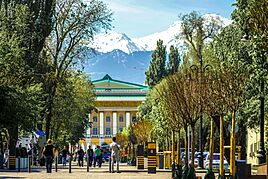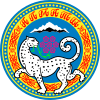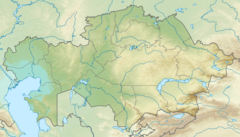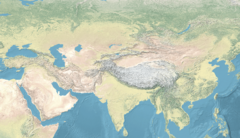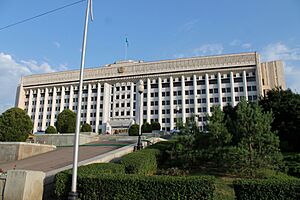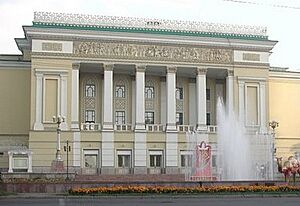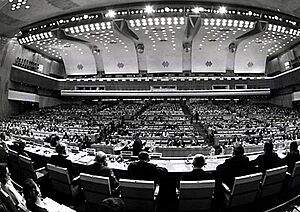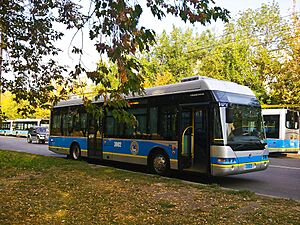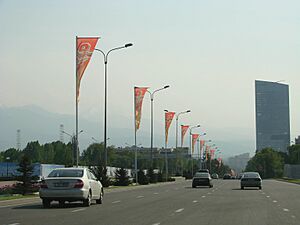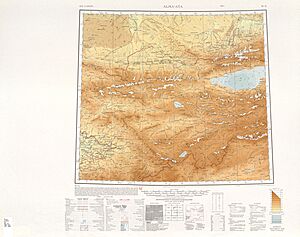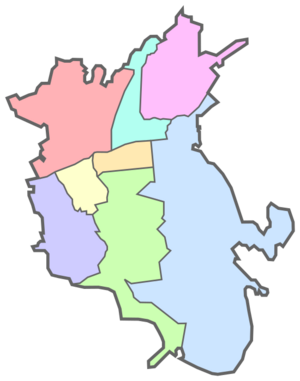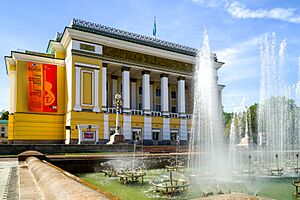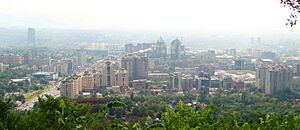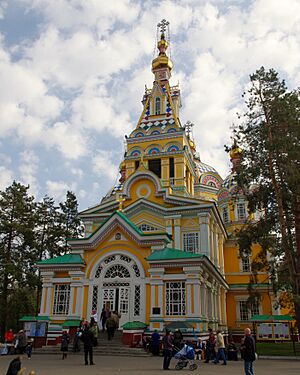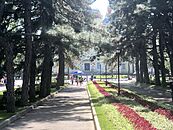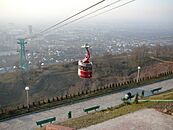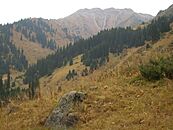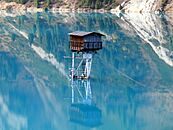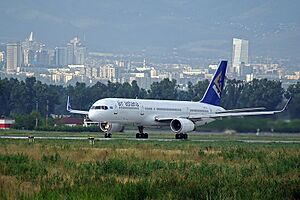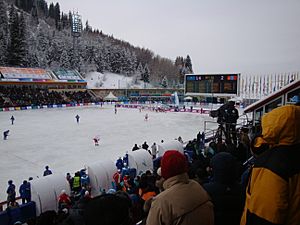Almaty facts for kids
Quick facts for kids
Almatу
Алматы
|
|||
|---|---|---|---|
|
Panfilov Street Esplanade
Abay Opera House
Ascension Cathedral
KBTU Building
Kok Tobe cable car
skyline of Almaty
|
|||
|
|||
| Nicknames:
"Southern Capital", "Apple City", "Big Apple", "ALA"
|
|||
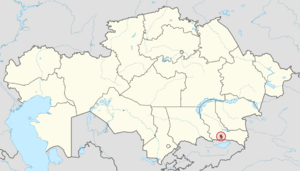 |
|||
| Country | Kazakhstan | ||
| First settled | 1000–801 BC | ||
| Founded | 1854 | ||
| Incorporated (city) | 1867 | ||
| Subdivisions | 8 districts | ||
| Government | |||
| • Body | City Mäslihat | ||
| Area | |||
| • City | 752 km2 (290 sq mi) | ||
| • Metro | 9,395 km2 (3,627 sq mi) | ||
| Highest elevation | 1,700 m (5,600 ft) | ||
| Lowest elevation | 500 m (1,600 ft) | ||
| Population
(1 April 2024)
|
|||
| • City | 2,249,500 | ||
| • Density | 2,991.4/km2 (7,748/sq mi) | ||
| GDP | |||
| • City | KZT 19,155 billion US$ 41.5 billion (2022) |
||
| • Per capita | KZT 8,985,600 US$ 19,461 (2022) |
||
| Time zone | UTC+5 (UTC+5) | ||
| Postal code |
050000–050063
|
||
| Area code(s) | +7 727 | ||
| ISO 3166 code | ALA | ||
| Vehicle registration | 02 (A – on older plates) | ||
| HDI (2021) | 0.841 very high · 1st |
||
| Climate | Dfa | ||
Almaty, also known as Alma-Ata in the past, is the largest city in Kazakhstan. It has a population of over two million people. Almaty was the capital city of Kazakhstan for many years. It served as the capital from 1929 to 1997. In 1997, the government moved the capital to Akmola, which is now called Astana.
Even though it's no longer the capital, Almaty is still very important. It's the main center for business, money, and culture in Kazakhstan. It's also the most populated and diverse city. Almaty is located in the mountains of southern Kazakhstan, close to the border with Kyrgyzstan. It sits at the base of the Trans-Ili Alatau mountains, between 700 and 900 meters (2,300–3,000 feet) above sea level. Two rivers, the Large and Small Almatinka, flow into the plains here.
Almaty is a special city in Kazakhstan. Like Astana and Shymkent, it's considered a "city of republican significance." This means it doesn't belong to any specific region. Since November 2017, Almaty has been part of the UNESCO Creative Cities Network because of its rich music scene.
Contents
- Discover Almaty's Past and Present
- Journey Through Almaty's History
- Almaty's City Layout and Districts
- Almaty's Location and Weather
- Who Lives in Almaty? (Demographics)
- Almaty's Rich Culture
- Almaty's Economy and Business
- Exploring Almaty's Cityscape and Attractions
- Getting Around Almaty (Transportation)
- Learning in Almaty (Education)
- Sports in Almaty
- Famous People from Almaty
- Almaty's Sister Cities
- Images for kids
- See also
Discover Almaty's Past and Present
Why Almaty is Called the "Southern Capital"
From 1929 to 1991, Almaty, then known as Alma-Ata, was the capital of Kazakhstan. This was during the time when Kazakhstan was part of the Soviet Union. After Kazakhstan became an independent country in 1991, the city was renamed Almaty in 1993. It remained the capital until 1997.
When the capital moved to Astana, Almaty became known as the "southern capital." It's still the biggest and most developed city in Kazakhstan. It's also very diverse, with many different ethnic groups living there. This diversity grew because of development during the Soviet era. Many workers and industries moved to Almaty during World War II.
Almaty is in the foothills of the Trans-Ili Alatau mountains in the southeast. The climate is generally mild, with warm, dry summers and cold winters. Because it's in an area where Earth's plates meet, there's a risk of earthquakes. Most tremors are small, but Almaty has experienced some powerful and damaging earthquakes in the past.
What Does the Name Almaty Mean?
The name Almaty comes from an old settlement called Almatau that was once nearby. One popular idea is that the name comes from the Kazakh word for 'apple' (алма). So, Almaty is often translated as "full of apples." Some even say it means "Apple Mountain."
The area around Almaty is famous for its wild apples. There's a lot of different kinds of wild apples here. Scientists believe that the wild Malus sieversii apple, which grows in the region west of the Tian Shan mountains, is the ancestor of all modern domestic apples.
Journey Through Almaty's History
Early Settlements in Almaty
Around 1000–900 BC, during the Bronze Age, the first farmers and animal herders settled in the Almaty area. Later, from 700 BC, the Saka and Wusun tribes lived here. They left behind many burial mounds, called tumuli, and old settlements. Famous discoveries include "The Golden Man" from the Issyk Kurgan and beautiful bronze artworks. During the Saka and Wusun times, Almaty became an early learning center.
Almaty from the 15th to 18th Centuries
Between the 15th and 18th centuries, Almaty saw less trade as the Silk Road became less active. European countries started trading more by sea. This period also brought big changes in who lived in the area and how they were governed.
The Dzungar invaded, taking control of the Kazakh people for a while. But the Kazakhs fought hard to protect their land. In 1730, they defeated the Dzungar in the Anyrakay mountains, about 70 km (45 mi) northwest of Almaty. The Senior Kazakh Horde, a group of Kazakh tribes, ruled this region. By the 1850s, the area became part of the Russian Empire.
How Verny Became Almaty

To control the region, Russia built a fort called Fort Zailiyskoe in 1854. It was located between the Bolshaya and Malenkaya Almatinka rivers. Soon after, it was renamed Fort Vernoe, meaning "Loyal." This wooden fort was later replaced with a brick wall.
By 1867, the settlement around the fort grew into a town called Almatinsk. It was quickly renamed Verny. On May 28, 1887, a strong earthquake almost completely destroyed Verny in just 11–12 minutes. By 1906, the city's population reached 27,000. Most of these residents were Russians and Ukrainians. Another major earthquake on January 3, 1911, again caused widespread destruction.
Almaty During the Soviet Era
After the Russian Revolution in 1918, Soviet power came to Verny. The city became part of the Turkestan Autonomous Soviet Socialist Republic. On February 5, 1921, Verny was renamed Alma-Ata, bringing back one of its old names.
In 1926, a railway called the Turkestan–Siberia Railway was approved for construction. This railway was very important for Kazakhstan's future growth. In 1930, the railway and a highway to Alma-Ata were finished. This helped the city grow even more.
On April 29, 1927, Alma-Ata became the capital of the Kazakh Autonomous Soviet Socialist Republic. This brought more trade and people to the city, helping it develop quickly. In 1930, the Alma-Ata airport opened, connecting the city directly to Moscow. This made Alma-Ata the main entry point to Kazakhstan by air.
During the 1930s, many intellectuals and leaders in Kazakhstan faced difficulties. Also, Kazakh nomads suffered greatly from starvation due to changes in their traditional way of life. In 1936, a plan was made to improve Alma-Ata as the new cultural capital.
World War II and Industrial Growth
During World War II, Alma-Ata's population and industries changed a lot. The government moved over 30 factories, 8 hospitals, 15 universities, and 20 cultural places from the war zones to Alma-Ata. Film companies from other cities also moved there. This brought many ethnic Russians to the city, making Kazakhs a smaller group in the region.
After the war, the city's industries grew even more. The population increased from 104,000 in 1919 to 365,000 in 1968. By 1967, Alma-Ata had 145 businesses. Most of these were light industries (like textiles and clothing) and food industries (like meat, flour, and fruit canning). Heavy industries, such as electrical engineering and car repair, also developed.
Modernizing the City
From 1966 to 1971, many new apartment buildings were constructed. These buildings were designed to be earthquake-proof. The Soviet government also built many schools, hospitals, and cultural centers. Important buildings from this time include Lenin's Palace, the Kazakhstan Hotel, and the Medeo Sports Complex.
In 1978, Alma-Ata hosted an important international conference on Primary Health Care. The Alma Ata Declaration from this meeting changed how public health was approached worldwide. On December 16, 1986, the Jeltoqsan riot happened in the city's main square. This was a protest against a government decision. Construction on the Almaty Metro subway system began on September 7, 1988. It finally opened on December 1, 2011, after 23 years.
Almaty After Independence
Kazakhstan became independent from the Soviet Union on December 16, 1991. On January 28, 1993, the city's name officially changed from the Russian Alma-Ata to the Kazakh name Almaty. In 1997, the President decided to move the capital from Almaty to Astana.
On July 1, 1998, a law was passed to give Almaty a special status. It was recognized as a major center for science, culture, history, finance, and industry.
A new plan for Almaty's development until 2030 was released in 1998. The goal is to make Almaty an eco-friendly and comfortable "garden-city." This plan includes building more homes and offices, improving transportation, and expanding the Almaty Metro. The first metro line opened in 2011, and an extension opened in 2015.
However, Almaty faces a big problem with air pollution. Cars are a major source of this pollution. Studies have shown that health issues like respiratory and blood diseases have increased in the city. In 2017, a system was launched to monitor air quality using a mobile app.
The city has also grown by adding nearby towns like Kalkaman and Kok Tobe. Many new apartment buildings and tall office skyscrapers have changed the city's look.
In March 2020, the first cases of COVID-19 were reported in Almaty. The pandemic led to lockdowns and changes in daily life. In January 2022, Almaty experienced unrest as part of a national political crisis.
Almaty's City Layout and Districts
Almaty is divided into 8 official city districts:
- Alatau district
- Almaly district
- Auezov district
- Bostandyk district
- Jetysu district
- Medeu district
- Nauryzbay district
- Turksib district
Almaty's Location and Weather
Almaty is in southeastern Kazakhstan, about 1000 km (620 mi) from the capital, Astana. Bishkek, the capital of Kyrgyzstan, is 190 km (118 mi) to the west. Ürümqi in China is almost 1000 km (620 mi) to the east.
The Mynzhylky mountain plateau is also in this region. It's a high plain located at the source of the Malaya Almaatinka river, 3000 meters (9,840 feet) above sea level.
Almaty's Climate
Almaty has a humid continental climate. This means it has hot summers and cold winters. The mountains around the city affect its weather, especially in the northern parts.
The average yearly temperature is about 10°C (50°F). January is the coldest month, averaging -4.6°C (23.7°F). July is the warmest, averaging 24.4°C (75.9°F). Frost usually starts around October 14 and ends around April 18. Temperatures above 30°C (86°F) happen about 36 days a year.
Almaty gets about 650 to 700 mm (25.6 to 27.6 inches) of rain each year. April and May are the wettest months. Sometimes, snow can fall as late as the end of May. The latest recorded snowfall was on June 17, 1987.
| Climate data for Almaty (1991–2020, extremes 1879–present) | |||||||||||||
|---|---|---|---|---|---|---|---|---|---|---|---|---|---|
| Month | Jan | Feb | Mar | Apr | May | Jun | Jul | Aug | Sep | Oct | Nov | Dec | Year |
| Record high °C (°F) | 16.8 (62.2) |
21.9 (71.4) |
29.8 (85.6) |
33.2 (91.8) |
35.8 (96.4) |
39.3 (102.7) |
41.7 (107.1) |
40.5 (104.9) |
38.1 (100.6) |
31.4 (88.5) |
26.5 (79.7) |
19.2 (66.6) |
41.7 (107.1) |
| Mean daily maximum °C (°F) | 0.5 (32.9) |
2.7 (36.9) |
9.9 (49.8) |
17.8 (64.0) |
22.9 (73.2) |
27.9 (82.2) |
30.5 (86.9) |
29.7 (85.5) |
24.5 (76.1) |
16.9 (62.4) |
8.1 (46.6) |
2.0 (35.6) |
16.1 (61.0) |
| Daily mean °C (°F) | −4.6 (23.7) |
−2.4 (27.7) |
4.5 (40.1) |
12.1 (53.8) |
17.1 (62.8) |
22.1 (71.8) |
24.4 (75.9) |
23.3 (73.9) |
18.0 (64.4) |
10.6 (51.1) |
2.9 (37.2) |
−2.7 (27.1) |
10.4 (50.7) |
| Mean daily minimum °C (°F) | −8.1 (17.4) |
−6.2 (20.8) |
−0.2 (31.6) |
6.8 (44.2) |
11.5 (52.7) |
16.4 (61.5) |
18.6 (65.5) |
17.3 (63.1) |
12.0 (53.6) |
5.3 (41.5) |
−1.0 (30.2) |
−6.1 (21.0) |
5.5 (41.9) |
| Record low °C (°F) | −30.1 (−22.2) |
−37.7 (−35.9) |
−24.8 (−12.6) |
−10.9 (12.4) |
−7.0 (19.4) |
2.0 (35.6) |
7.3 (45.1) |
4.7 (40.5) |
−3.0 (26.6) |
−11.9 (10.6) |
−34.1 (−29.4) |
−31.8 (−25.2) |
−37.7 (−35.9) |
| Average precipitation mm (inches) | 35 (1.4) |
43 (1.7) |
72 (2.8) |
112 (4.4) |
99 (3.9) |
59 (2.3) |
43 (1.7) |
34 (1.3) |
28 (1.1) |
50 (2.0) |
55 (2.2) |
44 (1.7) |
674 (26.5) |
| Average extreme snow depth cm (inches) | 15 (5.9) |
14 (5.5) |
5 (2.0) |
0 (0) |
0 (0) |
0 (0) |
0 (0) |
0 (0) |
0 (0) |
1 (0.4) |
2 (0.8) |
8 (3.1) |
15 (5.9) |
| Average rainy days | 4 | 5 | 11 | 14 | 15 | 15 | 15 | 10 | 9 | 10 | 8 | 6 | 122 |
| Average snowy days | 11 | 13 | 8 | 2 | 0.2 | 0 | 0 | 0 | 0.1 | 2 | 6 | 11 | 53 |
| Average relative humidity (%) | 77 | 79 | 71 | 59 | 56 | 49 | 46 | 45 | 49 | 64 | 74 | 79 | 62 |
| Mean monthly sunshine hours | 112.0 | 119.0 | 163.0 | 187.8 | 235.3 | 260.0 | 280.3 | 277.7 | 243.6 | 188.9 | 116.6 | 94.0 | 2,278.2 |
| Source 1: Pogoda.ru | |||||||||||||
| Source 2: NOAA | |||||||||||||
Earthquakes in Kazakhstan
Southern Kazakhstan, where Almaty is located, is an active earthquake zone. Strong earthquakes with magnitudes from 6.0 to 8.3 can happen here. In the past, three major earthquakes hit the area before the late 1800s. These were in 1770, 1807, and 1865.
In the last 125 years, three more powerful earthquakes caused a lot of damage in Almaty. Their centers were not far from the city. These happened in 1887 (Vernenskoe), 1889 (Chilik), and 1911 (Keminskoe). Each time, the city suffered widespread destruction.
Who Lives in Almaty? (Demographics)
Ethnic Groups in Almaty
Almaty is home to many different ethnic groups. Here's a look at the population in 2021 and 2023:
| Ethnic Group | 2021 | 2023 | ||
|---|---|---|---|---|
| Population | % | Population | % | |
| Kazakhs | 1,286,229 | 63.35% | 1,364,850 | 63.13% |
| Russians | 415,705 | 20.48% | 428,952 | 19.84% |
| Uyghurs | 112,753 | 5.55% | 116,623 | 5.39% |
| Koreans | 36,632 | 1.80% | 37,843 | 1.75% |
| Tatars | 30,449 | 1.50% | 30,858 | 1.43% |
| Ukrainians | 21,030 | 1.04% | 21,030 | 0.97% |
| Azeris | 18,890 | 0.93% | 19,891 | 0.92% |
| Dungans | 14,545 | 0.72% | 15,598 | 0.72% |
| Germans | 12,450 | 0.61% | 12,602 | 0.58% |
| Uzbeks | 11,445 | 0.56% | 12,715 | 0.59% |
| Other Ethnicity or Not Stated | 70,157 | 3.45% | 100,835 | 4.66% |
| Total | 2,030,285 | 100% | 2,161,797 | 100% |
Religions in Almaty
People in Almaty follow different religions. Here's a breakdown from 2021:
| Religion | 2021 | |
|---|---|---|
| Population | % | |
| Islam | 1,172,838 | 57.77% |
| Christianity | 353,477 | 17.41% |
| No Religion | 87,622 | 4.32% |
| Buddhism | 4,452 | 0.22% |
| Judaism | 2,184 | 0.11% |
| Other Religion | 4,865 | 0.24% |
| Not Stated | 404,847 | 19.94% |
| Total | 2,030,285 | 100% |
Almaty's Rich Culture
Almaty is often seen as the heart of Kazakhstan's culture, both classical and popular. It has a unique feel compared to other cities in the country. Almaty feels more European, with many cafes, restaurants, and green spaces. It's also a historical center for learning, partly because it was on the ancient Silk Road. Many Russian thinkers were also sent to live here.
The Abai Kazakh State Opera and Ballet Theatre has been a key part of the city's theater scene since 1934. The Kasteyev State Museum of Arts, founded in 1935, is the largest museum in Kazakhstan. It holds the biggest collection of art by Kazakh artists. The wild apple Malus siversii, which likely originated in the Almaty area, is an important symbol in the city's culture.
Theaters in Almaty
Theater started in Verny (old Almaty) soon after the Russian fort was built. The first play was staged on November 21, 1872. Later, plays were performed at public gatherings. The first opera was performed in 1913.
Theater really grew during the Soviet period when Alma-Ata became the capital. The Kazakh Drama Theater, the first professional Kazakh theater, moved here. The Opera and Ballet Theater (1934) and the Puppet Theater (1935) were also created. Other theater groups from different cities moved to the capital, including the Russian Drama Theater and the Korean Musical Comedy Theater.
After Kazakhstan became independent in 1991, many new independent theaters opened. These are often modern places for young people, created by passionate artists.
Museums to Explore
The first museum in Verny was created in 1874. It started with private collections of travelers and local people. This museum later became the foundation for the A. Kasteev Museum of Arts, which began as the Kazakh State Art Gallery in 1935. Its main goal was to collect the best works by Kazakh artists.
In 1936, museums in Moscow and Leningrad (now St. Petersburg) donated many paintings and sculptures to the gallery. By the late 1950s, the gallery had over 5,000 items. In the 1970s and 1980s, new buildings were built for existing museums. New museums also opened, focusing on books, musical instruments, and archeology. The Museum of the History of Almaty also opened, helping to organize the city's museums.
Cinemas in Almaty
The first film was shown in Verny in 1900. The first private cinema, "Twentieth Century," opened in January 1911. It even had the city's first power plant to show films! Sadly, it burned down in 1918.
In the 1930s, summer cinemas appeared in city parks, which later became full cinemas. By the early 1990s, Almaty had 21 cinemas. Some were "first screen" cinemas, showing new movies first. Others were "third screen," showing older films. Most cinemas had one screen, but a few had two halls. In the 2000s, cinemas started opening in shopping malls. This led to many older, standalone cinemas closing down.
Almaty's Economy and Business
Almaty creates about 20% of Kazakhstan's total economic output, or about $36 billion in 2010. It also brings in about 20% of government income and 60% of bank loans. Kazakhstan is the strongest economy in Central Asia, and Almaty is a key financial hub. It's considered a "Beta- Global City" by a 2012 study, meaning it's an important city in the world.
One of Almaty's biggest industries is finance. Its financial services contribute a lot to Kazakhstan's economy. Almaty is home to Halyk Bank, the largest bank in Central Asia, and other major banks like Kaspi Bank. The Kazakhstan Stock Exchange is also located here.
Almaty is growing as a regional center for finance and business. A new project called 'Almaty Financial District and Esentai Park' is being built. It's designed to be the largest business center in Central Asia. The Esentai Tower, a 37-floor building, is the tallest mixed-use building in Kazakhstan. It houses offices for big companies like HSBC. The first Ritz-Carlton Hotel in Kazakhstan opened in Esentai Tower in 2013.
Besides financial services, many media companies are in Almaty. Major TV channels like KTK and NTK are based here, along with several national newspapers.
There are plans to build a highway connecting Western Europe and Western China that will pass through Almaty. A new airport in Almaty is expected to handle about 45 million tons of cargo each year. Air Astana, a major airline, has its main office in Almaty.
Almaty's economy continues to grow, and this growth is expected to continue. To meet the increasing demand for electricity, the government is improving the power system.
Exploring Almaty's Cityscape and Attractions
In 1854, the Tsarist government built a military fort on the left bank of the Almaty River. This led to rapid development in the area. Important buildings like the Little Stanitsa and the Tatar Slobodka were constructed. A major earthquake in 1887 destroyed many brick houses. After the earthquake, more notable buildings were built, including the House of the Regiment of Military Assembly (1908) and the Ascension Cathedral. Architects like Paul Gourdet and Andrei Zenkov designed many of Almaty's beautiful old buildings.
From 1966 to 1972, most new buildings were earthquake-proof multi-story homes. Many schools, hospitals, and cultural centers were also built in a post-modernist style. Examples include Lenin's Palace (now Palace of the Republic, 1970), Hotel Kazakhstan (1977), and the Medeu sports complex (1971).
Beautiful Churches in Almaty
- St. Sophia Cathedral (Almaty)
- The Ascension Cathedral is a tall, 56-meter (184 ft) building. It was built in 1907 from blue Tien Shan spruce wood. It's famous for surviving a very strong earthquake in 1911. The inside walls were painted by a local artist, N. Khludov. During the Soviet period, it was used as a history museum. In 1995, it was given back to the Russian Orthodox Church, and services started again in 1997 after restoration.
Fountains of Almaty
As of 2007, Almaty had 125 fountains. The "Oriental Calendar" Fountain is one of them. It has 12 sculptures representing the 12 animals of the Kazakh 12-year animal cycle.
Today, there are over 120 fountains in Almaty. They work with the city's irrigation ditches to create a system of water features. Every year, at the end of spring, the city celebrates "Day of Fountains." On this day, all the city's fountains are turned on for the first time after winter. In 2006, a new fountain opened on Lake Sayran. This lake once had the tallest fountain in the Commonwealth of Independent States (CIS), with a water stream reaching 50 meters (164 feet) high. However, this fountain has been closed since 2008.
Fun Places to Visit in Almaty
Medeu Sports Complex
The Medeu is an outdoor speed skating and bandy rink. It's located in a mountain valley on the southeastern edge of Almaty. Medeu is 1,691 meters (5,548 feet) above sea level, making it one of the highest skating rinks in the world. It has a large ice area of 10,500 square meters (113,000 sq ft). A special system keeps the ice quality high.
Medeu was built in 1972, about 15 km (9 mi) from the city. It was known as "the factory of records" because 126 world records were set on its ice over 33 years. The high altitude, thin air, and pure mountain water create unique, high-quality ice. Above the complex, there's a dam to protect against mudslides and the Shymbulak ski resort. In the 1990s, Medeu hosted the Voice of Asia international music festival.
Shymbulak Ski Resort
Şymbūlaq is a popular ski resort near Almaty. It's in the upper part of the Medeu Valley, at 2,200 meters (7,200 ft) above sea level. The resort is about 25 km (16 mi) south of Almaty. It's known for its mild weather, many sunny days, and lots of snow from November to May. You can ski both during the day and at night. Shymbulak also holds a Guinness World Record for the highest ski slope available for night skiing.
Big Almaty Lake
Big Almaty Lake is a natural lake in the Trans-Ili Alatau mountains. It's 2,511 meters (8,238 ft) above sea level, about 15 km (9 mi) south of Almaty. Like many lakes in this mountain range, it was formed by an earthquake. The lake is a major source of drinking water for the region. You can reach the lake by car (about an hour from the city center), bike, or by hiking (a half-day trip).
First President's Park
The First President's Park is a large urban park in Almaty. It's located at the intersection of Navoi Street and Al-Farabi Avenue. The park officially opened in July 2010.
Work on the park started in 2001. It has three main areas: an avenue, a boulevard, and a tree and plant area. Many trees, like spruces and birches, were planted here. In 2008, about one hundred spruces and birches were planted to celebrate Almaty's participation in the Beijing Olympic Games torch relay. In 2011, another hundred Tien-Shan spruces were planted. There are also plans for water features covering a large area.
Kok Tobe Tower and Park
An aerial tramway (cable car) connects Almaty to Kök Töbe (meaning 'Blue Hill'). This is a popular recreation area on top of a mountain southeast of the city. It has many fun things for tourists, like a zoo, amusement park rides, and restaurants.
The Almaty Tower, the city's television tower, is on Kök Töbe hill. It was built between 1978 and 1983 and is 371.5 meters (1,219 ft) tall. The tower is located at an elevation of 1,130 meters (3,707 ft) above sea level, making it the tallest structure in Almaty. It's built to withstand earthquakes up to 10 points. The TV tower is a working station, so it's not open for public tours. However, it's lit up at night and can be seen from almost anywhere in the city.
Park of 28 Panfilov Guardsmen
The Park of 28 Panfilov Guardsmen is a major park in Almaty. It's in the east-central part of the city, around the Zenkov Cathedral. The park is named after the Panfilov Heroes. These were 28 soldiers from an Almaty infantry unit who bravely fought against Nazi German invaders near Moscow in World War II. They helped delay the German advance. In the park, there's an eternal flame and a large monument honoring soldiers from all 15 Soviet republics who died in the Russian Civil War and Great Patriotic War (World War II).
Getting Around Almaty (Transportation)
Air Travel
The closest airport to Almaty is Almaty International Airport. It's located about 15.5 km (9.6 mi) northeast of the city center.
City Transport
The Sayran Bus Terminal offers bus services to other cities in Kazakhstan, as well as international connections to Kyrgyzstan and China. The Sayakhat bus terminal serves areas north and east of the city.
Kazakhstan Temir Joly (the national railway) has two train stations: Almaty-1 (mostly for cargo, 20 minutes from the city) and Almaty-2 (in the city, mostly for passengers). The Almaty Metro subway system opened in 2011. A light rail line was also built in 2011.
A bicycle-sharing system called Almaty-bike started in September 2016. You can buy a monthly pass and use the bikes freely.
Learning in Almaty (Education)
Universities in Almaty
- Kazakh National Medical University
- Almaty Management University (ALMU)
- International Information Technology University (IITU)
- Kazakh-British Technical University (KBTU)
- University of International Business
- Almaty Institute of Power Engineering and Telecommunications
- Kazakh National Technical University (KazNTU)
- Al-Farabi Kazakh National University (KazNU)
- Suleyman Demirel University (SDU)
- KIMEP University (KIMEP)
- Kazakh-American University (KAU)
- Kazakh National Academy of Arts named by T.Zhurgenov
- Kazakh Academy of Sciences
- Kazakh Academy of Labour and Social Relations
- Kazakh National Pedagogic University (named after Abay)
- Turan University
- Kazakh Ablai Khan University of International Relations and World Languages
- Central Asian University (ЦАУ)
- Kazakh-German University (КНУ)
- Kazakh Leading Academy of Architecture and Civil Engineering
- Kazakh National Agrarian University (SHI, AEZVI)
- Narxoz University
- International Business Academy
Sports in Almaty
The famous bandy team Dinamo won the Soviet Championships in 1977 and 1990. They also won the European Cup in 1978. Their home stadium was Medeo. Bandy was played for the first time at the 2011 Winter Asian Games. Medeu was the main venue for the 2012 Bandy World Championship. The Federation of International Bandy has an office for Asia located in Almaty.
Almaty hosted the 2017 Winter Universiade, which included bandy.
The 2011 Asian Winter Games were held in Almaty and Astana. Ice hockey and ski jumping events took place in Almaty. Other events like biathlon, cross-country skiing, and alpine skiing were held in nearby areas like Shymbulak and Medeo.
The city's main football (soccer) team is FC Kairat, founded in 1954. They are one of Kazakhstan's most successful clubs. The futsal club AFC Kairat has won the UEFA Futsal Cup twice. The basketball team BC Almaty won the Kazakhstan Basketball Cup in 2015 and 2016.
Almaty's Olympic Dreams
After successfully hosting the 2011 Winter Asian Games, Almaty tried to host the 2014 Winter Olympics. However, it was not chosen as a candidate city. Almaty did host the 2017 Winter Universiade. The city also bid to host the 2022 Winter Olympics in August 2013 but lost to Beijing. Despite these attempts, Almaty might still consider bidding for the 2030 Winter Olympics.
Famous People from Almaty
- Zhansaya Abdumalik (born 2000), chess Grandmaster
- Altynai Asylmuratova (born 1961), prima ballerina
- Zarina Diyas (born 1993), tennis player
- Alexandra Elbakyan (born 1988), creator of Sci-Hub
- Nagima Eskalieva (born 1954), singer
- Dmitri Fofonov (born 1976), racing cyclist
- Kinbōzan Haruki (born 1997), sumo wrestler
- Ruslana Korshunova (1987–2008), model
- Regina Kulikova (born 1989), tennis player
- Dinmukhamed Konayev (1912–1993), politician
- Denis Ten (1993-2018), figure skater
- Olga Shishigina (born 1968), Olympic champion in hurdling
- Vladimir Zhirinovsky (1946–2022), politician
Almaty's Sister Cities
Almaty is connected with many cities around the world as "sister cities":
 Alexandria, Egypt
Alexandria, Egypt Bishkek, Kyrgyzstan
Bishkek, Kyrgyzstan Daegu, South Korea
Daegu, South Korea Istanbul, Turkey
Istanbul, Turkey Jeddah, Saudi Arabia
Jeddah, Saudi Arabia Malatya, Turkey
Malatya, Turkey Modena, Italy
Modena, Italy Mogadishu, Somalia
Mogadishu, Somalia Moscow, Russia
Moscow, Russia Rennes, France
Rennes, France Riga, Latvia
Riga, Latvia Rosario, Argentina
Rosario, Argentina Saint Petersburg, Russia
Saint Petersburg, Russia Tashkent, Uzbekistan
Tashkent, Uzbekistan Tel Aviv, Israel
Tel Aviv, Israel Tucson, Arizona, United States
Tucson, Arizona, United States Ürümqi, China
Ürümqi, China Muş, Turkey
Muş, Turkey Vilnius, Lithuania
Vilnius, Lithuania
Images for kids
-
Statue of Vladimir Lenin
See also
 In Spanish: Alma Ata para niños
In Spanish: Alma Ata para niños


